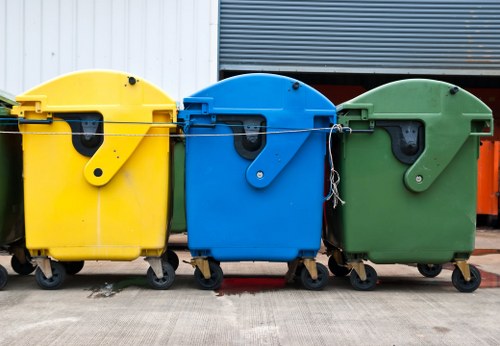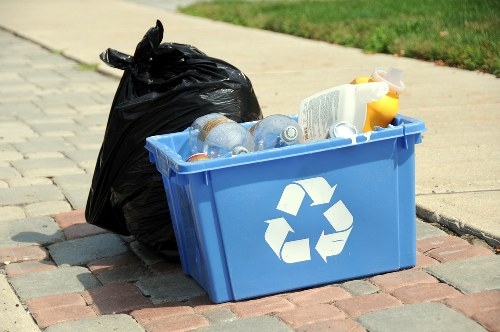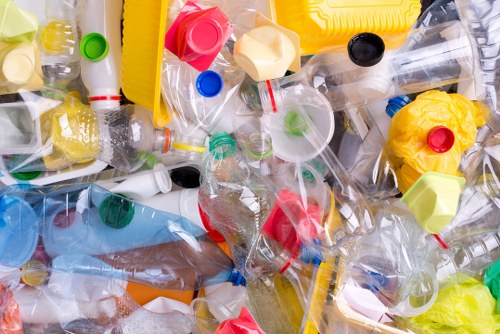Comprehensive Guide to House Clearance in Commercial Waste Disposal
Understanding House Clearance in the Context of Commercial Waste Disposal

House clearance plays a pivotal role in commercial waste disposal, ensuring that properties are efficiently cleared of unwanted items in a responsible and environmentally friendly manner. Whether you're a business undergoing renovation, relocation, or simply managing regular waste, understanding the nuances of house clearance can significantly impact both your operations and compliance with waste disposal regulations.
At its core, house clearance involves the removal of personal and commercial items from a property. This process goes beyond mere trash removal; it encompasses sorting, recycling, donating, and properly disposing of various materials. For businesses, this means creating a streamlined process that not only tidies up the workspace but also aligns with sustainability goals and legal requirements.
Effective house clearance can help businesses minimize clutter, improve operational efficiency, and contribute to a positive corporate image by demonstrating a commitment to environmental responsibility. Additionally, it can prevent potential legal issues related to improper waste disposal, which can result in hefty fines and damage to a company's reputation.
Benefits of Professional House Clearance Services

Engaging professional house clearance services offers numerous advantages for businesses looking to manage their waste disposal effectively.
- Efficiency: Professionals have the expertise and resources to clear large volumes of waste quickly, minimizing downtime for your business.
- Compliance: They ensure that all waste is disposed of in accordance with local regulations, avoiding potential legal complications.
- Environmental Responsibility: Many clearance services prioritize recycling and donating items, reducing the environmental footprint of your business.
- Cost-Effective: Outsourcing house clearance can be more economical than managing waste internally, especially when considering the costs of equipment, labor, and transportation.
Moreover, professional services often offer tailored solutions to meet the specific needs of different businesses, whether it's a small office or a large industrial facility. This flexibility ensures that every aspect of the clearance process is handled with precision and care.
By leveraging the expertise of professional house clearance providers, businesses can focus on their core activities while ensuring that waste disposal is handled efficiently and responsibly.
Key Steps in the House Clearance Process

The house clearance process involves several critical steps to ensure that waste is managed effectively and sustainably. Understanding these steps can help businesses plan and execute their clearance operations seamlessly.
1. Assessment and Planning
The first step involves assessing the scope of the clearance. This includes identifying the types and quantities of items to be removed, understanding any specific requirements, and planning the logistics of the operation. A thorough assessment helps in estimating costs and timelines accurately.
2. Sorting and Categorization
Once the assessment is complete, the next step is to sort items into categories such as recyclable materials, items for donation, hazardous waste, and general refuse. Proper categorization is essential for effective waste management and compliance with disposal regulations.
3. Removal and Transportation
After sorting, items are carefully removed from the property and transported to designated facilities. This step requires specialized equipment and trained personnel to handle large volumes and potentially heavy or delicate items safely.
4. Recycling and Disposal
Recyclable materials are processed accordingly, while non-recyclable waste is disposed of in compliance with environmental regulations. Hazardous waste requires special handling to prevent environmental contamination and ensure safety.
5. Final Cleanup
The final step involves thoroughly cleaning the property to ensure it is left in a pristine condition. This may include sweeping, mopping, and removing any residual debris.
Environmental Impact of House Clearance

House clearance, when conducted responsibly, can have a positive environmental impact. By prioritizing recycling and donating items, businesses can significantly reduce the amount of waste that ends up in landfills. This not only conserves natural resources but also reduces greenhouse gas emissions associated with waste decomposition.
Engaging in sustainable house clearance practices can enhance a company's reputation as an environmentally conscious entity. Consumers and partners are increasingly valuing businesses that demonstrate a commitment to sustainability, making responsible waste management a key component of corporate social responsibility.
Additionally, proper management of hazardous waste during house clearance prevents environmental contamination and safeguards public health. This involves adhering to strict guidelines and utilizing specialized facilities for the disposal of toxic materials.
Legal Considerations in Commercial Waste Disposal

Compliance with local and national regulations is a critical aspect of commercial waste disposal. Non-compliance can result in severe penalties, including fines and legal actions. Understanding the legal landscape surrounding waste management is essential for businesses to operate smoothly.
Key legal considerations include:
- Licensing: Ensuring that waste disposal services are licensed and recognized by relevant authorities.
- Documentation: Maintaining accurate records of waste disposal activities, including types and quantities of waste handled.
- Regulations: Adhering to specific regulations pertaining to different types of waste, such as hazardous materials, electronics, and bulky items.
- Reporting: Timely reporting of waste disposal activities to regulatory bodies as required.
By staying informed and compliant with waste disposal laws, businesses can mitigate risks and demonstrate their commitment to responsible environmental stewardship.
It's advisable for businesses to consult with legal experts or waste management professionals to ensure that all aspects of commercial waste disposal are handled in accordance with the law.
Choosing the Right House Clearance Service

Selecting a reliable house clearance service is crucial for effective commercial waste disposal. Here are some factors to consider when making your choice:
- Experience and Expertise: Look for companies with a proven track record in handling commercial property clearances. Experienced providers are more likely to manage the process efficiently and handle any unforeseen challenges.
- Reputation: Check reviews, testimonials, and references to gauge the company's reputation. A good reputation often signifies quality service and customer satisfaction.
- Range of Services: Ensure that the service provider offers comprehensive solutions, including sorting, recycling, donation, and proper disposal of various waste types.
- Compliance: Verify that the company adheres to all relevant regulations and possesses necessary licenses for waste disposal.
- Cost: Compare pricing structures to ensure that you receive value for your investment. Be wary of hidden fees and ensure transparency in pricing.
- Sustainability Practices: Choose services that prioritize eco-friendly practices, such as recycling and donating items, to align with your company's sustainability goals.
Taking the time to evaluate and select the right house clearance service can lead to more efficient operations, cost savings, and enhanced compliance with environmental standards.
Additionally, a reputable service provider will often offer personalized consultations to tailor their services to your specific needs, ensuring a smooth and hassle-free clearance process.
Cost Factors in House Clearance for Businesses

Understanding the cost factors involved in house clearance is essential for budgeting and financial planning. Several elements influence the overall cost of commercial waste disposal:
- Volume of Waste: The amount of waste to be cleared significantly impacts the cost. Larger volumes require more resources, time, and transportation efforts.
- Type of Waste: Hazardous or specialized waste disposal typically incurs higher costs due to the need for specialized handling and disposal methods.
- Location: Accessibility and distance from the disposal facility can affect transportation costs. Remote or hard-to-reach locations may result in higher fees.
- Urgency: Expedited services or tight deadlines may come with premium charges.
- Additional Services: Services such as deep cleaning, sorting, recycling, and data destruction can add to the overall cost.
To manage costs effectively, businesses should obtain detailed quotes that break down each component of the service. Comparing multiple providers can also help in finding competitive pricing without compromising on service quality.
Additionally, businesses can explore opportunities for cost savings by minimizing waste generation, optimizing sorting processes, and maximizing the recycling and donation of items.
Sustainability in House Clearance and Waste Disposal

Incorporating sustainability into house clearance practices is increasingly important for businesses aiming to reduce their environmental impact. Sustainable waste management practices not only contribute to environmental conservation but also enhance a company's reputation and align with consumer expectations.
Key sustainable practices include:
- Recycling: Separating recyclable materials such as paper, plastics, metals, and electronics to be processed and reused.
- Donation: Donating usable items to charities, non-profits, and community organizations to extend their lifespan and benefit those in need.
- Waste Reduction: Implementing strategies to minimize waste generation, such as optimizing inventory management and adopting eco-friendly packaging.
- Energy Efficiency: Using energy-efficient vehicles and equipment for the clearance process to reduce carbon emissions.
By prioritizing these practices, businesses can significantly lower their environmental footprint and contribute to a more sustainable future.
Moreover, sustainable house clearance can lead to cost savings through reduced waste disposal fees and potential tax benefits associated with donations and recycling initiatives.
Technological Advancements in Commercial Waste Disposal

Technology plays a significant role in enhancing the efficiency and effectiveness of commercial waste disposal. Innovations in this field are streamlining processes, improving tracking, and promoting sustainability.
Some notable technological advancements include:
- Waste Tracking Software: Digital tools that monitor waste generation, track disposal processes, and generate reports for compliance and optimization purposes.
- Automation: Automated sorting systems that increase the accuracy and speed of categorizing different types of waste, reducing human error and labor costs.
- Smart Bins: Internet of Things (IoT) enabled bins that monitor fill levels and optimize collection routes, enhancing operational efficiency.
- Recycling Technologies: Advanced recycling methods that enable the processing of a wider range of materials, increasing recycling rates and resource recovery.
Adopting these technologies allows businesses to manage their waste more effectively, reduce operational costs, and achieve higher sustainability standards.
Furthermore, integrating technology into waste management strategies provides valuable data insights, facilitating informed decision-making and continuous improvement in waste disposal practices.
Challenges in House Clearance and Waste Disposal

Despite the benefits of professional house clearance, businesses often face challenges that can complicate the waste disposal process. Understanding these challenges is the first step toward mitigating their impact.
- Volume Management: High volumes of waste can overwhelm clearance services, leading to delays and increased costs.
- Mixed Waste Streams: Handling mixed types of waste, especially hazardous materials, requires specialized knowledge and equipment.
- Regulatory Compliance: Navigating the complex landscape of waste disposal regulations can be daunting and may require expert consultation.
- Space Constraints: Limited space for temporary storage of waste before disposal can hinder the clearance process.
- Time Constraints: Tight schedules or urgent clearance needs can strain resources and affect service quality.
Addressing these challenges involves meticulous planning, effective communication with clearance providers, and a commitment to sustainable practices. Businesses can overcome these obstacles by selecting experienced partners, investing in training, and leveraging technology to streamline operations.
Proactive management and collaboration with waste disposal professionals can significantly reduce the impact of these challenges, ensuring a smooth and efficient house clearance process.
Future Trends in House Clearance and Waste Disposal

The landscape of house clearance and commercial waste disposal is continually evolving, driven by technological advancements, regulatory changes, and shifting societal values towards sustainability. Here are some future trends to watch:
1. Circular Economy Integration
The concept of a circular economy, where resources are reused and recycled to extend their lifecycle, is gaining traction. Future house clearance services are likely to focus more on minimizing waste through recycling, refurbishing, and repurposing materials.
2. Increased Use of AI and Automation
Artificial Intelligence (AI) and automation will play a larger role in waste sorting, predictive maintenance of disposal systems, and optimizing logistics. These technologies will enhance efficiency and reduce the reliance on manual labor.
3. Enhanced Recycling Technologies
Advancements in recycling technologies will enable the processing of more complex materials, increasing recycling rates and resource recovery. Innovations such as chemical recycling for plastics are paving the way for more sustainable waste management.
4. Smart Waste Management Systems
IoT-enabled smart waste management systems will become more prevalent, allowing for real-time monitoring of waste levels, optimizing collection routes, and improving overall waste management efficiency.
5. Stricter Environmental Regulations
With growing awareness of environmental issues, governments are likely to implement stricter regulations on waste disposal. Businesses will need to stay informed and adapt their waste management practices to comply with these new standards.
Keeping abreast of these trends will enable businesses to proactively adapt their waste disposal strategies, ensuring they remain compliant, efficient, and environmentally responsible.
Embracing innovation and sustainability in house clearance will not only benefit the environment but also offer competitive advantages in the market.
Implementing an Effective House Clearance Strategy

Developing and implementing an effective house clearance strategy is essential for businesses aiming to manage their waste disposal efficiently and sustainably. Here are key steps to consider:
- Set Clear Objectives: Define what you aim to achieve with your house clearance. Objectives may include reducing clutter, complying with regulations, minimizing environmental impact, and optimizing operational efficiency.
- Conduct a Waste Audit: Assess the types and volumes of waste your business generates. This audit will help identify areas for improvement and inform your clearance strategy.
- Choose the Right Partner: Select a professional house clearance service that aligns with your objectives, offers comprehensive services, and demonstrates a commitment to sustainability.
- Develop a Schedule: Plan the clearance process to minimize disruption to your business operations. This may involve scheduling during off-hours or in phases.
- Train Your Staff: Educate your employees on proper waste segregation and the importance of maintaining a clutter-free workspace. Staff involvement is crucial for the success of your clearance strategy.
- Implement Sustainable Practices: Prioritize recycling, donation, and proper disposal of hazardous materials. Incorporate sustainability into your daily operations to reduce future waste generation.
- Monitor and Review: Continuously monitor the effectiveness of your house clearance strategy and make necessary adjustments. Regular reviews help in identifying new opportunities for improvement.
By following these steps, businesses can create a structured and effective house clearance strategy that not only manages waste efficiently but also supports broader sustainability goals.
An effective strategy also involves setting measurable targets, tracking progress, and fostering a culture of continuous improvement within the organization.
Case Studies: Successful House Clearance in Commercial Settings

Examining real-world examples can provide valuable insights into the benefits and best practices of house clearance in commercial waste disposal. Here are a few case studies highlighting successful implementations:
Case Study 1: Office Renovation and Clearance
A mid-sized marketing firm undergoing a major office renovation partnered with a professional house clearance service to manage the disposal of old furniture, electronics, and office equipment. The clearance service conducted a thorough assessment, sorted items for recycling and donation, and ensured all waste was disposed of according to regulations. As a result, the firm minimized downtime, reduced waste disposal costs, and enhanced its sustainability profile.
Case Study 2: Retail Store Closure
A large retail chain decided to close one of its stores and required comprehensive house clearance services. The service provider efficiently handled the removal of inventory, fixtures, and hazardous materials. By implementing a structured clearance plan, the retail chain was able to close the store smoothly while recovering value from returned goods and ensuring compliance with environmental regulations.
Case Study 3: Manufacturing Facility Upgrade
A manufacturing company upgrading its facility needed to clear out old machinery and surplus materials. The clearance service specialized in industrial waste management, ensuring safe removal and proper recycling of metal and electronic components. This collaboration not only facilitated the upgrade process but also supported the company's commitment to sustainable manufacturing practices.
These case studies demonstrate the versatility and effectiveness of professional house clearance services in various commercial contexts. By adopting best practices and partnering with experienced providers, businesses can achieve successful waste management outcomes.
Best Practices for Sustainable House Clearance

Adopting best practices in house clearance can enhance sustainability and efficiency in commercial waste disposal. Here are some recommendations:
- Plan Ahead: Develop a clear clearance plan that outlines objectives, timelines, and responsibilities. Proper planning prevents last-minute issues and ensures a smooth process.
- Engage Stakeholders: Involve employees and other stakeholders in the clearance process. Their cooperation is essential for effective waste segregation and maintaining a clutter-free workspace.
- Prioritize Recycling and Donation: Maximize the recovery of materials by prioritizing recycling and donating usable items. This reduces waste and supports community initiatives.
- Minimize Single-Use Items: Reduce the use of single-use products in your operations to lower the overall waste generated.
- Implement Digital Solutions: Utilize digital tools for waste tracking and management to enhance efficiency and transparency.
- Educate and Train: Provide training to employees on proper waste management practices and the importance of sustainability.
- Monitor and Improve: Regularly review your waste management practices and seek opportunities for continuous improvement.
By adhering to these best practices, businesses can create a sustainable and efficient house clearance process that aligns with their environmental and operational goals.
Continuous commitment to these practices fosters a culture of sustainability within the organization, leading to long-term benefits and positive environmental impact.
Conclusion: The Integral Role of House Clearance in Commercial Waste Disposal

House clearance is a fundamental component of commercial waste disposal, offering businesses a structured and sustainable approach to managing unwanted items. By leveraging professional clearance services, companies can ensure compliance with regulations, enhance operational efficiency, and promote environmental responsibility.
Effective house clearance not only minimizes clutter and optimizes workspace but also aligns with broader sustainability goals, contributing to a positive corporate image and fostering a culture of environmental stewardship.
As technology advances and sustainability becomes increasingly important, house clearance practices will continue to evolve, offering new opportunities for businesses to manage waste more effectively and responsibly.
Investing in efficient and sustainable house clearance strategies is not just a practical necessity but also a strategic advantage in today’s environmentally conscious market.
Contact us today to learn how our professional house clearance services can help your business achieve its waste management and sustainability goals.
Book your service now and take the first step towards a cleaner, greener, and more efficient workspace.